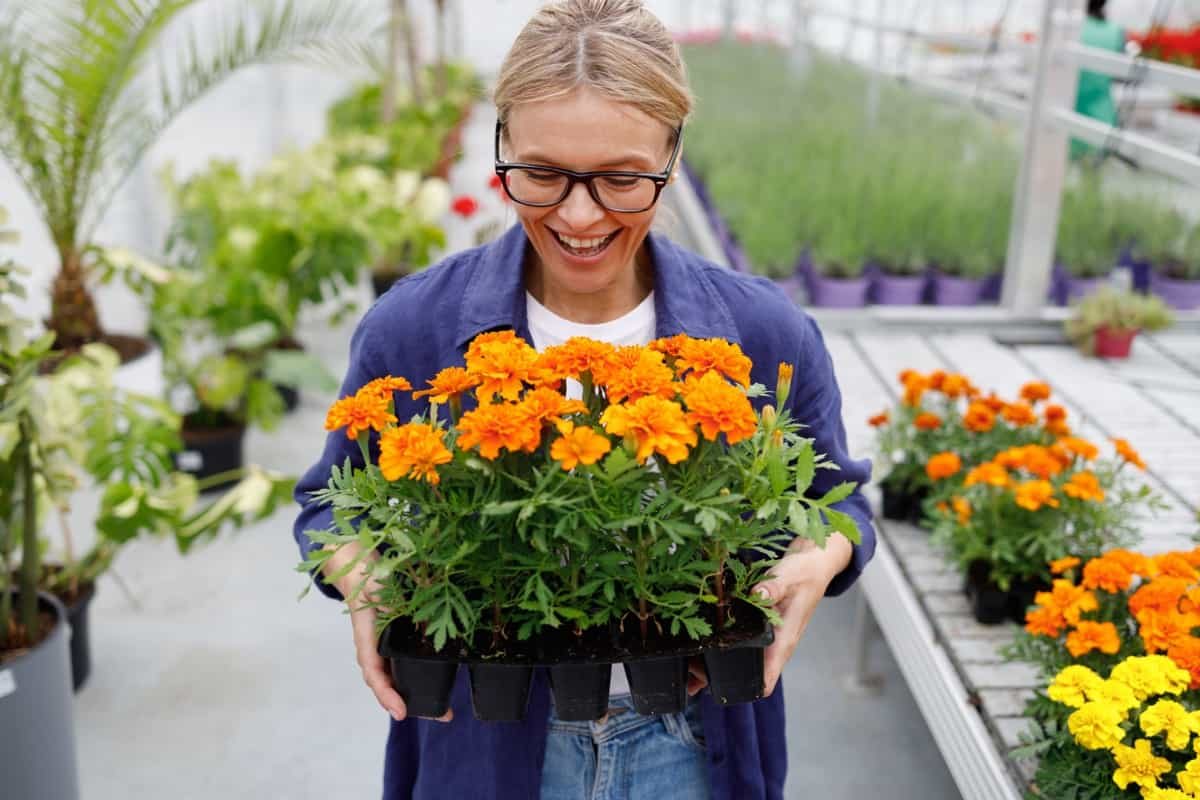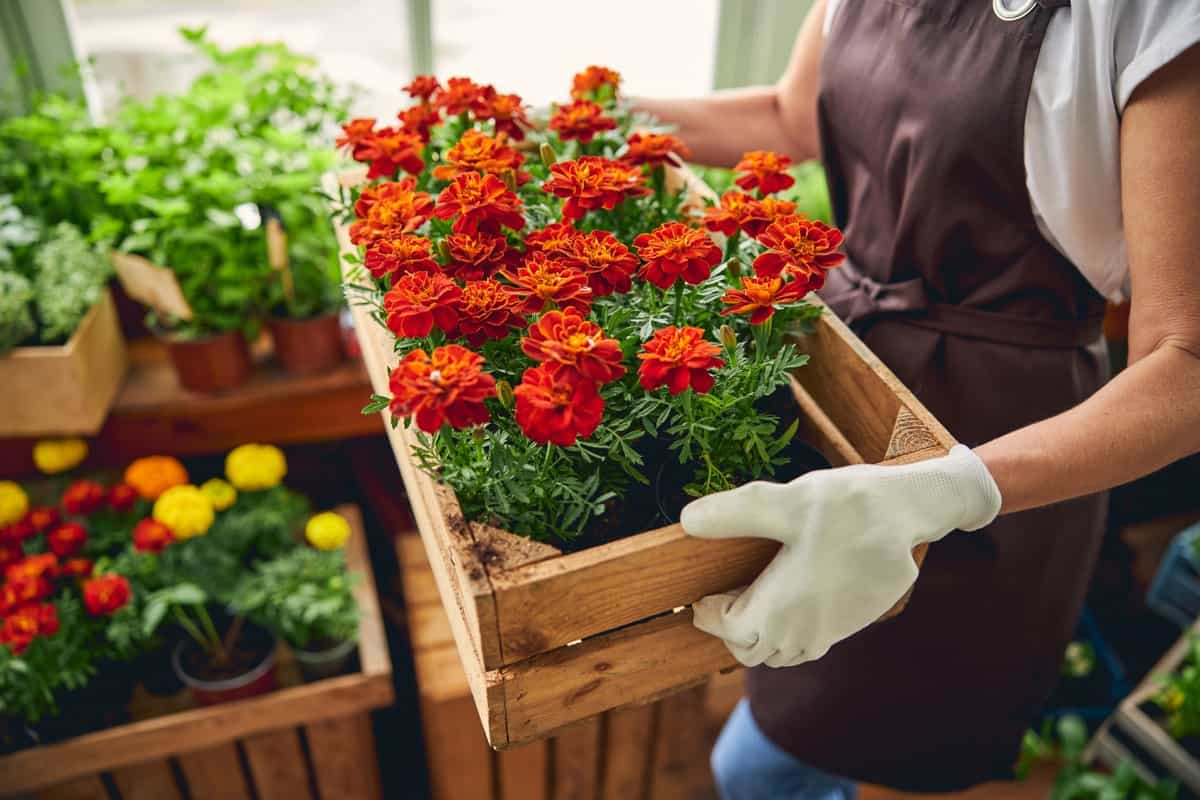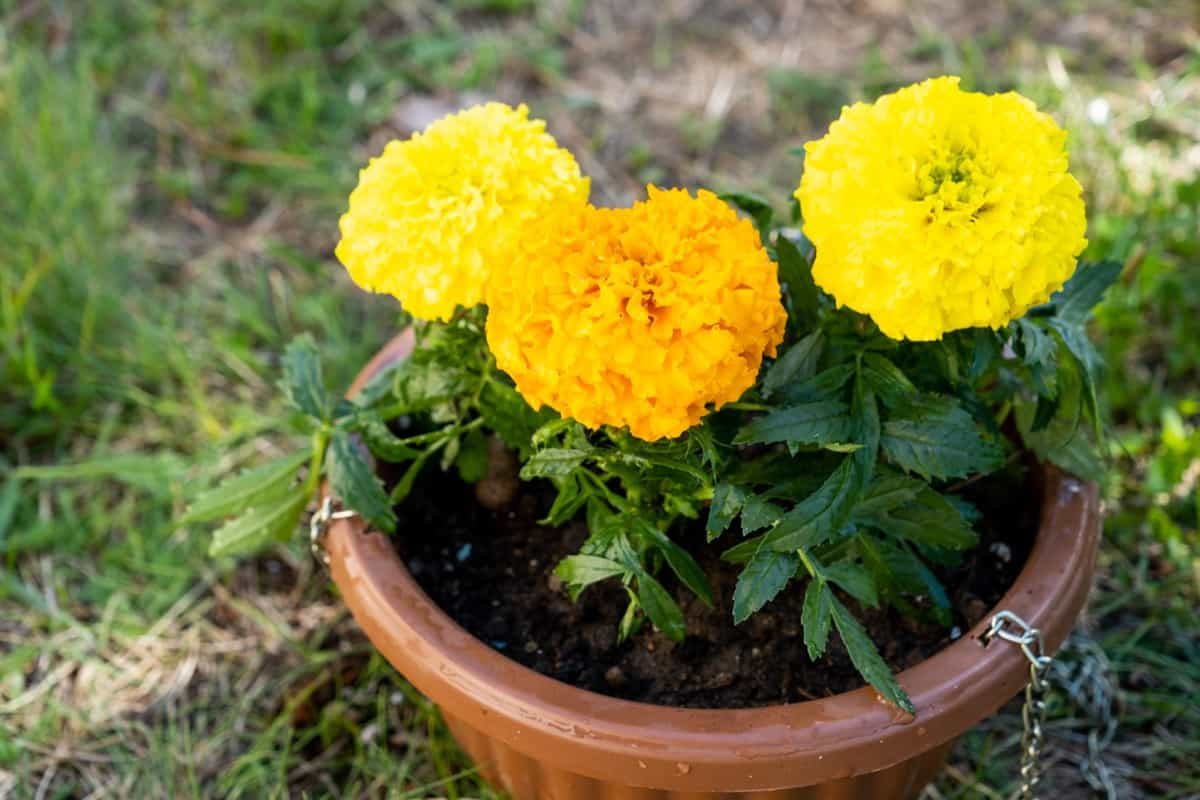Marigolds are beautiful and versatile flowers that can be easily grown in pots. Marigolds (Tagetes spp.) are delightful, easy-to-grow annual flower that comes in vibrant shades of yellow, orange, and red. Marigolds bloom all summer, adding a cheerful touch to any garden or balcony.

How to Start Marigolds in Pots
Best Practices for Growing Marigolds in Pots
- Growing Marigolds in containers is an easy and rewarding way to add color and beauty to your outdoor space. One of the most critical aspects of container gardening with Marigolds is choosing the right pot size.
- You’ll want a well-draining blend that’s nutrient-rich. A mixture of vermiculite, peat moss, perlite, and compost can provide optimum conditions for growth.
- A good quality potting mix with added perlite or vermiculite can improve drainage while retaining moisture vital for healthy growth.
- Marigold propagation from seeds requires proper planting techniques like sowing seeds half an inch deep into the soil mix during spring; remember not to overwater the plant as this could lead to root rot.
- Take care of pests and diseases through regular inspections where necessary use eco-friendly measures such as neem oil-based products avoiding synthetic pesticides, which are harmful to human health, and beneficial insects, including bees.
Choosing The Right Pot Size for Growing Marigolds
- The ideal container for growing Marigolds should be at least 10 inches deep and wide. This ensures that the plants have enough room to establish their root systems, which is essential for their growth.
- A pot that’s too small may lead to overcrowding, causing the roots to become entangled and stunted. On the other hand, a pot that’s too large may retain excess moisture, leading to root rot. Selecting an appropriately sized container is vital when growing healthy and vibrant Marigold plants in pots.
Ideal Soil Mix for Potting Marigolds
- The right soil mix for potting Marigolds is crucial to their growth and development. Marigolds require well-draining, nutrient-rich soil to thrive in containers.
- To create the ideal soil mix, combine equal parts of peat moss or coconut coir, perlite or vermiculite, and high-quality potting soil. This combination will provide good drainage while retaining moisture and nutrients.
- Another important factor to consider is the pH level of the soil. Marigolds prefer slightly acidic soil with a pH range between 6.0-7.0. You can test your soil’s acidity using a simple at-home testing kit available at most garden centers.
Sunlight Requirements for Container-Grown Marigolds
- Marigolds are sun-loving flowers that thrive in full sunlight. When growing Marigolds in containers, adequate sunlight is crucial for their healthy growth and blooming.
- Ideally, it would help if you placed your Marigold pots in an area that receives at least six hours of direct sunlight daily. Providing shade during the hottest part of the day is essential if you live in a hot climate or during peak summer months.
- If you don’t have access to ample natural light sources, supplementing with artificial light can help ensure your Marigolds receive the necessary amount of light they require.
In case you missed it: 7 Causes of Dying Marigolds and How to Fix Them?

How to Propagate Marigold in Pots?
- The first step in propagating Marigolds in pots is to choose healthy parent plants from which to take cuttings. Selecting young, vigorous plants will give you the best chance for successful propagation.
- Once you have selected your parent plants, it’s time to take cuttings. Using scissors or pruning shears, carefully cut 4–6-inch stems from the plant just below a node (where leaves attach). Remove the lower leaves from each cutting, leaving only two to three sets of leaves at the top.
- To increase your chances of success, dip the bottom end of each plant cutting into rooting hormone before planting it into moist soil mix in a small pot. Water thoroughly and cover with a plastic bag to create a humid environment around the new plant.
- Check on your newly propagated Marigolds regularly and keep them moist but not overly wet until they begin to grow new roots and shoots. Once established, transplant them into larger containers filled with nutrient-rich soil mix so they can continue growing and blooming beautifully throughout their lifespan.
Watering and Fertilizing Techniques for Potted Marigolds
- These are crucial components in the growth of Marigolds in pots. Over-watering the plant can lead to root rot, while under-watering can cause stunted growth and wilted leaves. It is advisable to water your potted Marigolds regularly but not excessively.
- To determine if it’s time to water, check the soil moisture level by inserting a finger about an inch deep into the soil. If it feels dry, then it’s time for watering. Avoid splashing water on the plant leaves, which can encourage fungal diseases.
- When fertilizing potted Marigolds, use a balanced fertilizer with equal nitrogen, phosphorus, and potassium (NPK). Fertilize every two weeks during their growing season or once a month during winter dormancy.
- For organic fertilizers, you may opt for compost or well-rotted manure with high essential nutrients required for plant growth.
How to Successfully Plant Marigold Seeds in Pots?
- Select a pot with drainage holes at least 10 inches deep and wide. This will provide ample space for the root system to expand.
- Next, choose high-quality potting soil that is well-draining but also retains moisture. Fill the container with soil up to an inch below the rim.
- Sow the seeds on the soil, spacing them about an inch apart. Then gently sprinkle a thin layer of soil over them and water lightly using a spray bottle or misting attachment on your watering can.
- Keep your newly planted Marigold seeds in a warm location where they receive bright light but not direct sunlight until germination occurs (usually within 7-14 days). Once they sprout, move them to a sunny spot with 6 hours of direct sun daily.
- Water the Marigold plant regularly, but be careful not to overwater as this can cause rotting of both roots and stems. When seedlings reach two inches tall, thin out any overcrowded plants by removing weaker ones or transplanting them into their containers.
Preventing Pests and Diseases in Potted Marigolds
- The first step to preventing Marigold pests and diseases is to choose healthy, disease-resistant plants or grow them from seeds treated with fungicide. This will give you a good head start in keeping your Marigolds strong and healthy.
- Next, make sure your potting mix is well-draining and not too compacted. Poorly draining soil can affect root rot, attracting pests like fungus gnats. Adding perlite or vermiculite to the soil mixture can help improve drainage.
- Another way to prevent pest infestations is by practicing good watering habits. Overwatering the Marigold plant can lead to fungal growth, while underwatering stresses the plant and makes it more susceptible to insect attack.
- Regularly inspecting your Marigold plants for signs of pests or disease is crucial for catching problems early on. Consider using natural remedies like neem oil spray or insecticidal soap as a last resort if an infestation does occur. These treatments are generally safe for humans but should be used sparingly and only as needed.
In case you missed it: The Best Fertilizer for Marigolds: When and How to Apply

Harvesting and Caring for Blooming Marigolds in Pots
- For harvesting Marigold, ensure you regularly deadhead by removing spent blooms to encourage new growth. You can do this by simply pinching off the old flowers with your fingers.
- Additionally, be sure to water your Marigolds regularly and deeply. To promote even more blooms, consider fertilizing your Marigolds every two weeks with a balanced fertilizer that is high in phosphorus. This will help encourage healthy root development and robust flowering.
Conclusion
Growing Marigolds in pots is an excellent way to bring color and vibrancy to your garden or balcony. Potting Marigolds allows you to easily move them around, control their environment, and enjoy the benefits of these beautiful flowers all season long. Growing Marigolds in pots adds beauty to your space and provides many benefits like repelling insects naturally and attracting pollinators such as bees and butterflies.
- Ultimate Guide to Ossabaw Island Hog: Breeding, Raising, Diet, and Care
- Ultimate Guide to Juliana Pig: Raising Facts, Size, Diet, Care, and Lifespan
- Raising Lleyn Sheep: Disadvantages, Price, Uses, Characteristics, and Care
- Ultimate Guide to Meishan Pig: Breed Facts, Breeding, Raising, and Care
- Ultimate Guide to Teacup Pigs: Raising, Diet, Lifespan, Cost, and Care
- Guide to Raising Poll Dorset Sheep: Facts, Profile, Characteristics, Uses, and Care
- Ultimate Guide to Bighorn Sheep: Characteristics, Diet, Lifespan, Breeding, and Lifecycle
- Ultimate Guide to Raising Katahdin Sheep: Farming Facts, Breed Profile, Uses, and Care
- Ultimate Guide to Raising Oreo Cows: Belted Galloways Farming Facts, Profile, Uses, and Care